Bone Vivant
It’s been a heroic year for Sam Neill. The actor saved the day in the quirky independent film “The Dish,” as the Australian scientist responsible for broadcasting television images of man’s first walk on the moon; he rescued the crew of a sunken submarine in the true-life TV movie “Submerged”--and he’s about to go one-on-one with a newer, smarter assortment of ferocious dinosaurs in “Jurassic Park III,” which stampedes into theaters on Wednesday.
“It’s about time I did a bad guy, isn’t it?,” Neill notes wryly during a recent interview in Los Angeles.
Well, not quite yet: After sitting out the first sequel, “The Lost World: Jurassic Park” (1997), Neill is back as Dr. Alan Grant, the paleontologist who survived the cloned creatures in 1993’s dino-saga “Jurassic Park.” In the wake of the well-publicized mayhem documented in the prior films, funding for Grant’s research is nearly as extinct as dinosaurs were once thought to be. Early in “Jurassic III,” an original story written by Peter Buchman and Alexander Payne and Jim Taylor (the others were based on novels by Michael Crichton), Grant declares that “no force on heaven or Earth” could get him to face the larger-than-life reptiles again. He probably hadn’t seen the box office for “Lost World”--$229 million in the U.S. alone.
Desperate for money to continue his work, Grant allows himself to be coerced by the promise of big bucks into accompanying Paul and Amanda Kirby (William H. Macy and Tea Leoni) on what he is told will be an aerial tour of Isla Sorna, a remote island that has become a breeding ground for the genetically engineered dinosaurs last seen in “Lost World.” Grant has no idea of the hidden agenda behind the Kirbys’ urgent need to get to the island. When he realizes the couple plans to actually spend time on the island, Grant protests, but there’s little time for debate: The plane is damaged and forced to land. Surviving the crash turns out to be the least of the problems faced by those aboard, as they are quickly set upon by the island’s carnivorous inhabitants.
Neill admits it’s a challenge acting against often nonexistent creatures that were digitally inserted after filming. “It’s hard to work with [empty] space, but this is part of the reality of working in modern cinema. The better ILM [Industrial Light & Magic] gets, more and more unlikely things will be put into that space.
“Obviously,” he adds, “it’s easier to act against a real velociraptor.”
The “real” velociraptor was the creation of Stan Winston, the wizard of live-action robotic dinosaurs. Winston’s animatronic creatures “feel like real ones,” Neill says. “They’re three-dimensional, they breathe. They seem to have a kind of intelligence about them, even when they’re not in the scene.”
Neill has traveled from New Zealand, where he was raised, to this Universal Studios sound stage, which has been converted into a lush, forest-like setting to replicate the film’s island location. Atmospheric low lighting, rattan furnishings and leafy decor abound, set off incongruously by crystal chandeliers hanging from the rafters above and an industrial tile floor underfoot. Stationary replicas of some of the film’s dinosaurs are placed strategically amid the flora and fauna.
Pointing to a life-sized raptor model, Neill says, “When it’s still like that, it’s just a sculpture. But once they’re moving, there are times you’re completely convinced that you are working with a real creature.”
He talks about the technological advances that have been made since the first “Jurassic Park” film, noting that “you could see from the moment you walked on the stage that these creatures were way ahead of anything we were working with years ago.”
And what of Dr. Grant--aside from being eight years older and presumably wiser, how has he changed since film audiences last saw him? “I think the actor playing Dr. Grant actually does him better this time,” Neill offers slyly, adding, “I think Grant’s better delineated, more interesting. He’s gnarlier, kind of a chewy old guy.”
*
According to “Jurassic III” director Joe Johnston (“Jumanji,” “October Sky”), “This Alan Grant is completely different from before, and it’s mostly because of what he had been through.”
Johnston, who took over the “Jurassic” reins from Steven Spielberg, who directed the first two movies and serves as executive producer on “Jurassic III,” points out that Grant is “more cynical now, a little more sarcastic. He’s broken up with Ellie Sattler [Laura Dern, who puts in a small but pivotal appearance in the film], so he’s completely on his own, and he’s gone back to what he loves to do best, which is crawl around in the dirt and look for dinosaurs.”
Neill does plenty of crawling around in the dirt in “Jurassic III,” but little is in the peaceful pursuit of mainland fossil study. Once the story moves to Isla Sorna, the action-driven script calls for Grant and the others to be pursued by a bloodthirsty spinosaurus (which is larger than and does battle with the Tyrannosaurus rex familiar to audiences from the earlier “Jurassic Park” films) and flying pteranodons.
When face to face with a pack of velociraptors, the paleontologist finds himself putting his theory of raptor intelligence to the ultimate field test. “You need to keep upping the ante on these films and take the audience to the next level in terms of the action and the dinosaurs and the special effects,” says Johnston of the $92-million film’s nonstop action pace. “Jurassic III” offers no “meanwhile back at the ranch”-style cutaways to other locations; it’s all Neill and company duking it out mano-a-dino.
“I wanted to return a little bit more to what made the first [‘Jurassic Park’ film] so great,” Johnston notes, “which was a bunch of people getting on this island and not knowing what they were getting into. In the second film, they knew why they were going, and everyone had an agenda. In this one, all they really want to do is survive.”
The pace took its toll on the actors. “Run, jump, dive, drown, burn, you name it, we do it,” Neill recalls of the demanding 20-week shoot which took cast and crew from the Hawaiian islands of Kauai and Oahu to Los Angeles-area locations. “The ironic thing about action is that it always takes longer to make. The faster a film moves on screen, the more time it takes to make the damn thing.”
The 53-year-old Neill made his feature film debut in 1977’s “Sleeping Dogs” and amassed an impressive string of international credits including “My Brilliant Career” (1979), “Reilly: The Ace of Spies” (1983), “A Cry in the Dark” (1988), “Dead Calm” (1989) and “The Hunt for Red October” (1990)--on the big and small screens before achieving mainstream recognition in 1993, when he starred in “Jurassic Park” and “The Piano.”
The seeming incongruity of the roles he played in those films is not unusual for the versatile actor, who is comfortable going back and forth between fanciful projects such as “Jurassic Park” and “Merlin,” the 1998 TV miniseries in which he played the title role--and those more grounded in real-life events such as “The Dish” and “The Zookeeper,” an upcoming drama in which Neill portrays a Balkan soldier stranded at an abandoned zoo in a city beset by civil war.
There’s an “everyman” quality to Neill which has enabled the soft-spoken actor to comfortably inhabit a broad range of characters without resorting to grandstanding or physical transformation. He’s believable as the avuncular scientist in “The Dish” and equally credible as dashing super-spy “Reilly.”
And while he literally and metaphorically wears the good-guy hat in “Jurassic III,” Neill will get his wish and play the bad guy in the upcoming made-for-TNT thriller “Framed,” in which he co-stars with Rob Lowe as a criminal trying to corrupt an honest policeman.
Neill claims he has no master plan for the parts he chooses. “I don’t really have any particular criteria except that it must interest me,” he says. “That’s all. I don’t consider things like, ‘Will this be good for my career?’ That’s of no consequence. There are other considerations, like whether it’s going to be shot in an interesting place. But the principal thing is, is it of interest?”
When Neill first got on board the “Jurassic Park” thrill ride, his contract tied him to three films. Since his character didn’t appear in “The Lost World,” could that mean Dr. Grant is due for yet another showdown with prehistoric reptiles run amok in the modern world?
“I certainly wouldn’t be averse to the idea,” Neill says, “but I think it would be a stretch to get Grant back on the island.” If “Jurassic III” turns out to be a blockbuster, that stretch could get shorter.
More to Read
The biggest entertainment stories
Get our big stories about Hollywood, film, television, music, arts, culture and more right in your inbox as soon as they publish.
You may occasionally receive promotional content from the Los Angeles Times.










